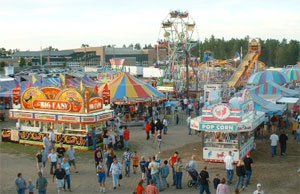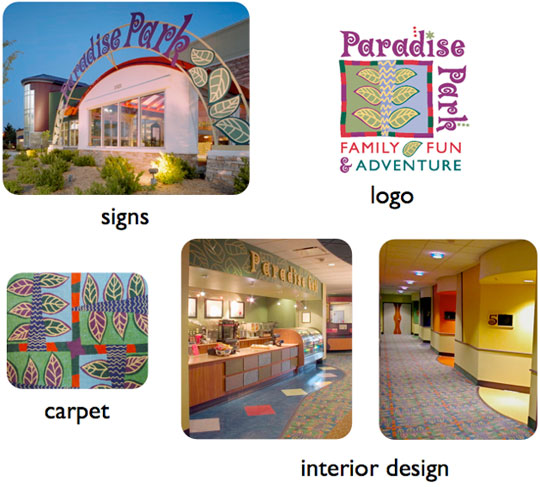
Vol. X, No. 7, November-December 2010
- Editor's Travelogue
- The great FEC theming myth
- Hamburgers still king of sandwiches
- What's next: the future is already here
- Randy's blogging
- Managing prime food and beverage costs for maximum profitability
- The challenge of designing environments for families with children
- 2011 Foundation Entertainment University dates
- The culture of eating occasions
- Current projects
The great FEC theming myth
 Perhaps we need to look back at the roots of family entertainment centers (FECs) to understand one of the continuing myths about the design of FEC-type facilities; that they have to be heavily themed or be designed like a carnival. FECs’ roots can probably be traced back to carnivals and seaside boardwalk arcades and amusement parks. Many of the earliest FECs took those same amusements and games, moved them into a big box store in suburbia, and basically followed the same design paradigm of flashy designs and blinking lights. Many FECs continue to follow that design paradigm. Other FECs looked at the theme park industry and decided that FECs needed to be heavily and immersively themed, such as jungle, circus, Mayan or some other exotic theme.
Perhaps we need to look back at the roots of family entertainment centers (FECs) to understand one of the continuing myths about the design of FEC-type facilities; that they have to be heavily themed or be designed like a carnival. FECs’ roots can probably be traced back to carnivals and seaside boardwalk arcades and amusement parks. Many of the earliest FECs took those same amusements and games, moved them into a big box store in suburbia, and basically followed the same design paradigm of flashy designs and blinking lights. Many FECs continue to follow that design paradigm. Other FECs looked at the theme park industry and decided that FECs needed to be heavily and immersively themed, such as jungle, circus, Mayan or some other exotic theme.
Both these approaches to theming demonstrate a basic misunderstanding of the differences of the FEC experience, its economics and the design approach that works best.
The first differences deal with frequency of visits and per capita spending. Carnivals, theme parks and visits to the seashore and its amusement venues usually occur only once a year. The average customer spends a considerable amount of money on their visit, much more than they would be willing to do on a frequent basis multiple times a year. Think of the difference of going to a theme park or the seashore boardwalk and spending $50+ per person on admissions, food and beverage and souvenirs and visiting your local movie theatre where you might spend $15 or so on tickets and concessions. You sure are willing to go to the movies more frequently than the theme park. There is an inverse relationship between per capita spending and frequency of visits; the lower the spend rate, the higher the frequency of visits.
FECs draw from a much smaller market population due to their shorter length-of-stay and generate a lower attendance than theme parks. To attract the attendance needed to support their economics, theme parks have to draw from a large regional metropolitan population, most of whom might only come once a year, spend the day and spend a lot more money than at an FEC. Pity the poor FEC. Much like the movie theater, to make their economics work, FECs have to attract multiple visits from a much smaller market area population that only spends about 2 hours and less money. There is a direct relationship between length-of-stay and market reach (in distance or drivetime). The shorter the stay, the less the market reach.
The economics of a FEC and a theme park are miles apart. When you take total annual attendance times per capita spending, you get total annual revenues, which in turn dictate what level of investment can be made. Theme parks have high revenues supporting their large capital cost, which includes costly theming. The revenues of FECs are substantially lower, meaning their development budgets are far less.
So the bottom line is that FECs need to have high repeat appeal to attract multiple visits from a local market population, which doesn’t spend a lot per visit. FECs can’t afford the capital expenditure budgets that theme parks do for extensive theming.
So besides the higher cost of exotic theming, why isn’t theme park or carnival theming appropriate? The first issue deals with the difference between being outdoors and being indoors. Outdoors you have nature, trees and vegetation, the smell and roar of the ocean, the sun and breeze, the sky and clouds. In a sense that is the stage for the rides. Move indoors and you lose that. You have to do something else to create the ambiance. Another issue is who your target market is. The socio-economics of the average carnival attendee is lower than the target socio-economics of whom you need to attract to be successful in the FEC industry. Increasingly consumers are making decisions based on whether what is being offered conforms to their own self-image. To put it bluntly, the ambiance of carnival is a turnoff to the higher socio-economic, it fails to fit their self-image. The problem with exotic theming is frequency of visits. What works once or a few times a year can become overwhelming and old hat when you visit the facility monthly or even weekly. It’s what we call theme burnout, and it’s the exact reason themed night clubs have such short lives and have to completely remake themselves every few years.
FECs need to be themed, but it is a completely different type of theming than what most people think theming is. Theming in the broader sense is a unified and integrated design, look or motif giving the business a distinctive coordinated look or personality that is integral to its brand identity. It is not necessarily a heavy-handed or generic type theme, it’s just great design. In fact, with a well-executed theme, no one will call you themed. Legally it is called ‘trade dress,’ the distinctive and unique look of the facility. Trade dress is a form of intellectual property that is protected under trademark law. Think of the design of an Applebee’s or Chili’s restaurant, or a Target department store. The minute you see it, you recognize what it is. If you were blindfolded without seeing its exterior and the blindfold was taken off once inside, you would still instantly recognize where you were.
A FEC’s theming needs to be familiar, yet distinctive. It should use the familiar in unfamiliar ways. Guests need to feel comfortable like it is part of their community, while at the same time feeling the place is special and different. Theming an FEC is no different in concept than theming a restaurant. In fact, some of the most successful FECs came out of the restaurant industry rather than the carnival and gameroom industry. Think about the long-term successof Dave & Buster’s and Chuck E. Cheese’s. Both are themed, but in the broader concept of theming versus the over-the-top type.
In addition to over-the-top theming, there are other theming errors that are frequently made:
- Mistaking the themed environment for the experience, rather than merely the set within which the guest experience occurs
- Thinking a great theme increases the quality of the underlying goods, services and entertainment and permits you to charge higher prices. This is the mistake the now defunct theme restaurants made. Due to their high cost of theming, they charged higher prices for the food. The public quickly recognized the food was not worth the price they were being charged. The theming did not raise the quality of the food nor its perceived value.
An important consideration in developing a theme for a FEC is to pick a design that is as timeless as possible, one that will not be considered out of date in just a few years, but hopefully will last for at least 10 years. The public’s tastes for fashion, colors and design change with time. You might not remember the ‘fern restaurant’ design style from the 1970s. That design approach would be considered very out of date today.
Developing a timeless theme requires understanding what is current today as well as forward looking design trends. A timeless theme might draw on forward looking trends or use at truly timeless design style, but present it in some unique and contemporary way to create a distinctive theme for the FEC while preserving its timelessness.
Greenmarket and resourceful are just two of the color palettes forecast in 2010.

Here’s one example of a FEC theme. It’s Paradise Park in Lee’s Summit, Missouri. When our company designed the indoor and outdoor center, we developed a theme or brand identity that incorporated the landscaping of its outdoors with a leaf pattern that was integrated into its coordinated carpet, signage, logo and overall design. The theming also used a common color palette and selection of finish materials. It doesn’t look like your typical ‘themed’ FEC, but it sure works great for its targeted mid to upscale family market.

Great theming for FEC-type facilities isn’t what most people think it is. Getting the theme right can make all the difference for financial success.
Vol. X, No. 7, November-December 2010
- Editor's Travelogue
- The great FEC theming myth
- Hamburgers still king of sandwiches
- What's next: the future is already here
- Randy's blogging
- Managing prime food and beverage costs for maximum profitability
- The challenge of designing environments for families with children
- 2011 Foundation Entertainment University dates
- The culture of eating occasions
- Current projects


